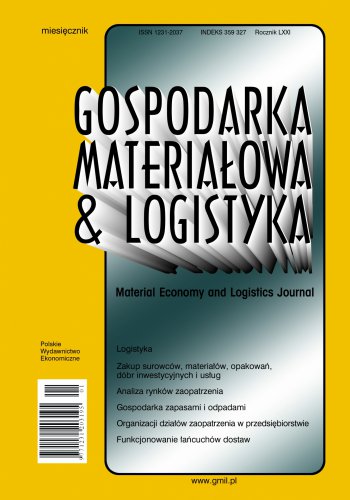Scenariusze eksploatacji i obsługi maszyn w cyber-fizycznych systemach produkcji w Przemyśle 4.0
The article presents scenarios of machine operation and maintenance in the cyber-physical production systems in Industry 4.0. The inspiration for the publication is the growing popularity of the concept of Industry 4.0. The integration of different technologies: electronics, computer technology, industrial robotics, artificial intelligence etc., have contributed to the change in the ways of machine operation and maintenance (we say about machine we think about robots). Cyber-physical production systems are built with different units, objects, and they are the fundamental pillars of Industry 4.0, completely change the robots service. Traditional technology required continuous supervision, maintenance and operation of machines. Employees were required both during the start-up of the machines and during their operation. Cyber-physical production systems, unlike homogeneous systems, are systems with different elements (components) and characteristics, and the participation of the operators (employees) in these systems is kept to a minimum or completely eliminated. Intangible components of the production system, e.g. computer programmes, data processing and transmission, controls the operation of devices. The goal of this publication is to initiate a discussion about scenarios of changes in the technical exploitation of machines in cyber-physical production systems in Industry 4.0.
References
Almada-Lobo, F. (2016). The Industry 4.0 revolution and the future of manufacturing execution systems (MES). Journal of Innovation Management, 3 (4), 16–21. http://www.open-jim.org/article/view/249 (30.03.2020). https://doi.org/10.24840/2183-0606_003.004_0003.
Durmus, M. (2019). Smart predictive maintenance: the key to Industry 4.0. https://www.aisoma.de/smart-predictive-maintenance-the-key-toindustry-4-0/ (30.03.2020).
Elliot, B.R., Hill, G. (1999). Total Productive Maintenance. Is it time to move on? Logistics Solutions, 1.
Erboz, G. (2017). How to define industry 4.0: The Main Pillars of Industry 4.0. Researchgate.net.
Fatorachian, H. and Kazemi, H. (2018). A critical investigation of Industry 4.0 in manufacturing: theoretical operationalisation framework. Journal Production Planning & Control. The Management of Operations, 29(8), 633-644, https://doi.org/10.1080/09537287.2018.1424960.
Garg A. and S.G. Deshmukh (2006). Maintenance management: literature review and directions. Journal of Quality in Maintenance Engineering, 12 (3), 205.
Gajdzik, B. (2014). Autonomous and professional maintenance in metallurgical enterprises as activities within Total Productive Maintenance. Metalurgija, 53 (1), 269–272.
Gubbi, J. et al. (2017). Internet of Things (IoT): A vision, architectural elements, and future directions. Elsevier Available at: http://www.sciencedirect.com/science/ article/pii/S0167739X13000241 (30.03.2020).
Honczarenko, J. (2004). Roboty przemysłowe: budowa i zastosowanie. Warszawa: WNT.
Hermann, M., Pentek, T., Otto, B. (2015). Design Principles for Industrie 4.0 Scenarios: A Literature Review. Dortmund: Uniwersytet Techniczny w Dortmundzie.
Jasperneite J. (2012). Was hinter Begriffen wie Industrie 4.0 steckt. Computer & Automation. (30.03.2020).
Kagermann, H. , Wahlster, W. and Helbig, J., eds. (2013). Recommendations for implementing the strategic initiative Industrie 4.0, Final report of the Industrie 4.0 Working Group.
Kazimierczak, J. (2000). Eksploatacja systemów technicznych. Gliwice: Wydawnictwo Politechniki Śląskiej.
Lasi, H. , Kemper, H.G., Fettke, P., Feld, T., Hoffmann, M. (2014). Industry 4.0. Business & Information Systems Engineering, 4 (6), 239–242. https://doi.org/10.1007/s12599-014-0334-4.
Lee, E.A. (2006). Cyber-physical systems are computing foundations adequate. In: Position Paper for NSF Workshop On Cyber-Physical Systems: Research Motivation, Techniques and Roadmap. Citeseer.
Lee, J., Ardakani, H.D., et al. (2015). Industrial Big Data Analytics and Cyber-physical Systems for Future Maintenance & Service Innovation. Procedia CIRP, 38 (November), 3–7. https://doi.org/10.1016/j.procir.2015.08.026.
Lee, J., Bagheri, B. & Kao, H. (2015). Research Letters: A Cyber-Physical Systems architecture for Industry 4.0-based manufacturing systems. Manufacturing Letters, 3, 18–23. https://doi.org/10.1016/j.mfglet.2014.12.001.
Legutko, S. (2009). Trendy rozwoju utrzymania ruchu maszyn i urządzeń. Eksploatacja i Niezawodność, 2, 8–16.
Olszewski, M. (2006). (red.) Podstawy mechatroniki. Warszawa: Wydawnictwo REA s.j.
Patel, M. (2018). The Future of Maintenance. White paper. Bengaluru: Infosys. https://www.infosys.com/industries/aerospacedefense/white-papers/Documents/enabled-predictive-maintenance.pdf (30.03.2020).
Piątek Z., Jak usprawnić utrzymanie ruchu korzystając z IoT? 9.01.2019. http://przemysl-40.pl/index.php/2019/01/09/jak-usprawnicutrzymanie-ruchu-korzystajac-z-iot/ (30.03.2020).
Raports IFR. (2019) Executive Summary World Robotics (2019); Industrial Robots (September, 18, 2019), Service Robots. https://ifr.org/free-downloads.
Raport PwC. (2019) Industrial Manufacturing Trends.
Rudtsch, V., Gausemeier, J., and Judith Gesing Tobias Mittag Stefan Peter (2014). Pattern-based Business Model Development for Cyber-Physical Production Systems, In: 8th International Conference on Digital Enterprise Technology — DET 2014 — Disruptive Innovation in Manufacturing Engineering towards the 4th Industrial Revolution. ScienceDirect, Elsevier, Procedia CIRP 25, 313–319. https://www.sciencedirect.com/science/.../pii/ S2212827114010750 (30.03.2020). https://doi.org/10.1016/j.procir.2014.10.044.
Rüßmann, M., Lorenz, M., Gerbert, Ph., Waldner, M., Justus, J., Engel, P. and Harnisch, M. (2015). Industry 4.0: The Future of Productivity and Growth in Manufacturing Industries. www.inovasyon.org/pdf/bcg.perspectives_Industry.4.0_2015.pdf (30.03.2020).
Santos, K., Loures, E., Piechnicki, F., Canciglieri, O. (2017). Opportunities Assessment of Product Development Process in Industry 4.0. Procedia Manufacturing, 11, 1358–1365. www.sciencedirect.com (30.03.2020). https://doi.org/10.1016/j.promfg.2017.07.265.ScienceDirect 27th International Conference on Flexible Automation and Intelligent Manufacturing, FAIM2017, 27–30 June 2017, Modena, Italy, 1358–1365.
Spong, M.W., Vidyasagar M. (1997). Dynamika i sterowanie robotów, Warszawa: WNT.
Wang, K.S. (2016). Intelligent Predictive Maintenance (IPdM) system — Industry 4.0 scenario. WIT Transactions on Engineering Sciences, (113), 260–268.
Wang, L., Törngren, M. and Onori, M. (2015). Current status and advancement of cyber-physical systems in manufacturing. Journal of Manufacturing Systems, 37, 517–527. https://doi.org/10.1016/j.jmsy.2015.04.008.
Wang, K.S., Wang, Y. (2012). Towards a next generation of manufacturing: Zero-Defect Manufacturing (ZDM) using data mining approaches. In: J.J. Rodriguez-Andina (ed.). Data mining for Zero-Defect Manufacturing. New York: Tapir Academic Press. https://doi.org/10.1007/s40436-013-0010-9.

